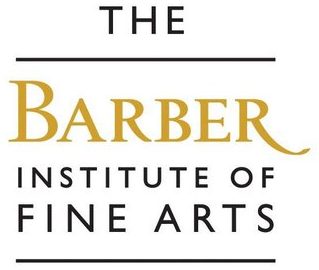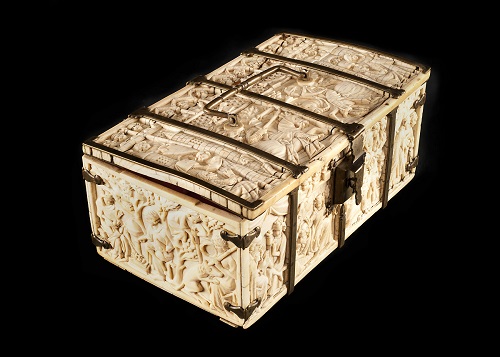Unrecorded French Artist
Casket with Scenes of Chivalry and Love
Paris (?), early 14th century
Elephant ivory; brass brackets, straps and handles (later additions)
9.5 x 23.2 x 13.6cm
This is one of nine such caskets (or coffrets) known to have survived complete, most others are in prestigious museum collections around the world, including the British Museum, London, and the Metropolitan Museum of Art, New York. They are linked by their iconography; they each depict scenes in bas-relief from medieval courtly literature and give insights into the period’s fascination with the concept of courtly love. They were all made in Paris – from the mid 13th century onwards, Paris was regarded as a centre of artistic excellence.
This casket was first recorded in the collection of Francis Annesley, 1st Viscount Valentia, Lord Privy Seal to King James I (VI of Scotland). It is likely originally to have been given as a gift, as a token of love and matrimony, to hold valuables such as love letters or jewellery. It is carved with scenes from mythological stories popular during the Middle Ages, which allude to the themes of chivalry and romance. The lid shows a jousting tournament divided into four by metal bands; the central panel depicts the joust itself and the outer ones the preparation – the knights kneel before ladies who present them with their helmets and shields. The front shows stories from Aristotle and Campaspe, and Pyramus and Thisbe. In the first, the bearded Aristotle speaks with Campaspe, the mistress of Aristotle’s most illustrious pupil Alexander the Great, whom he had warned against her. In the second, Alexander and two friends gaze down from the battlements as Aristotle, humiliated by the revenge-seeking Campaspe, carries her on his hands and knees through an orchard.
By contrast, in the next scene, there are two doomed lovers, Thisbe and Pyramus. Their story is derived from classical antiquity, but is now best known from Shakespeare’s play, A Midsummer Night’s Dream. The casket panel shows Thisbe hiding in a tree from a lion which has just devoured an ox, the blood of which stains the garment Thisbe dropped in her haste. When her lover Pyramus discovers this and assumes she is dead, he kills himself. Thisbe runs herself through with a sword as she embraces her dead lover – this is the scene shown in the final panel. The sides of the casket depict, on the left side, Tristan and Iseut, and the capture of the Unicorn; the right side, the knight, Enyas, delivering a maiden from a wild man of the woods. On the back, there are four episodes from the adventures of Gawain and Lancelot.
The casket is made of elephant tusks, characterised by their pearly surface, which would have held connotations of purity and chastity for the medieval viewer. Originally, elephant tusks were used to make objects for religious use, including Bible book covers. However, from the medieval period onwards, they were used to carve luxury works of art for private consumption, and other items, such as combs and mirror backs, were also made out of ivory.
The ivory was normally taken from African Savannah elephants, the largest of elephants, with curved tusks. Its brutal trade was linked to international markets that supplied dyes to the textile industry in Northern Europe. The use of ivory is now illegal; trade has been restricted since 1975 by the Convention on International Trade in Endangered Species of Wild Fauna and Flora, and a ban on international trade was introduced in 1990. The 2018 Ivory Act is limited to the UK and is stricter; it bans the trade and movement of ivory regardless of its provenance, age and form. There are exemptions for museums and galleries, which allow them to acquire, lend and borrow items made of ivory. Despite the legal bans, African elephants continue to be hunted illegally, with devastating impacts on their population – which is currently classed as ‘vulnerable’ by the World Wildlife Fund. For more information about the Barber’s casket, see the work listed on the Courtauld’s Gothic Ivories Project here.
Purchased 1939 (No. 39.26)

